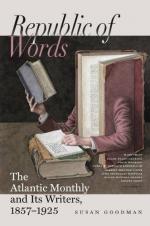We must leave almost unnoticed the author’s elaborate chapter on the pedigree and the early history of the Winthrop family. He is content to begin this side of those who “came over with the Conqueror,” and to accept for ancestry men and women untitled, of the sterling English stock, delvers of the soil, and spinners of the fabrics of which it affords the raw material. He finds almost his own full name introducing a record on the Rolls of Court in the County of York for the year 1200. Adam Winthrop, grandfather of our Governor, himself the father, as he was also the son of other Adams, was born in Lavenham, Suffolk, October 9, 1498, six years after the discovery of this country by Columbus, and in the same year in which occurred the voyage of Vespucius, who gave his name to the continent. This second Adam Winthrop, at the age of seventeen, went to London, binding himself as an apprentice for ten years under the well-esteemed and profitable guild of the “clothiers,” or cloth-workers. At the expiration of his apprenticeship, in 1526, he was sworn a citizen of London, and, after filling the subordinate dignities of his craft, rose to the mastership of his company in 1551. The Lordship of the Manor of Groton, at the dissolution of the monasteries, was granted to Adam Winthrop in 1544. Retaining his mercantile relations in the great city, and probably residing there at intervals, he seated himself in landed dignity at his manor, and there he died in 1562. His memorialist now holds in his possession the original bronze plate which was put upon his tomb three hundred years ago, and which was probably removed to give place to the new inscription connected with the repairs already referred to. This ancient sepulchral brass bears in quaint old English characters the following inscription:—“Here lyeth Mr. Adam Wynthrop, Lorde & Patron of Groton, whiche departed owt of this Worlde the IXth day of November, in the yere of owre Lorde God MCCCCCLXII.” His widow, who had been his second wife, married William Mildmay; and his daughter Alice married Mr. Mildmay’s son Thomas, who, being afterwards knighted, secured to the cloth-worker’s daughter the title of “Lady Mildmay.” In the cabinet of the American Antiquarian Society at Worcester, the visitor, on the asking, may be gratified with the sight and touch of a curious old relic which will bring him almost into contact with a most agreeable family-circle of the olden time. It is a serviceable posset-pot, with a silver tip and lid, both of which are gilded, the cover, still playing faithfully on its hinge, being chased with the device of Adam and Eve in the garden partaking of the forbidden fruit. An accompanying record reads as follows:—“At ye Feast of St. Michael, Ano. 1607, my Sister, ye Lady Mildmay, did give me a Stone Pot, tipped & covered wth. a Silver Lydd.” How many comforting concoctions and compounds, alternating with herb-drinks and medicated potions, may have been quaffed or swallowed




